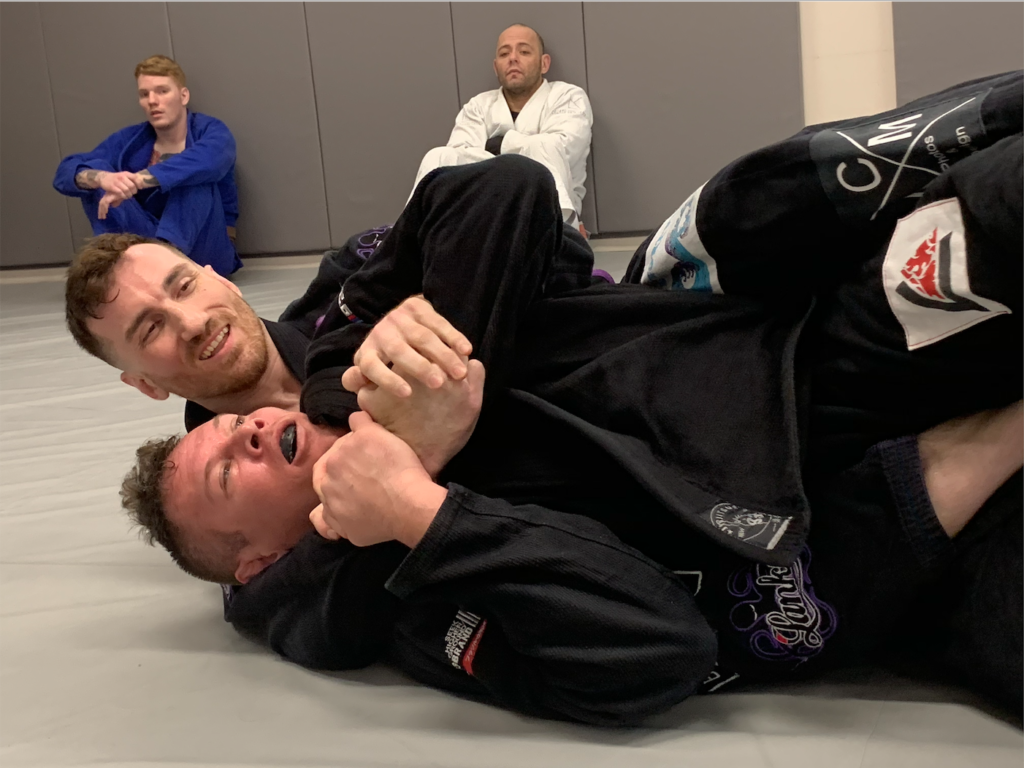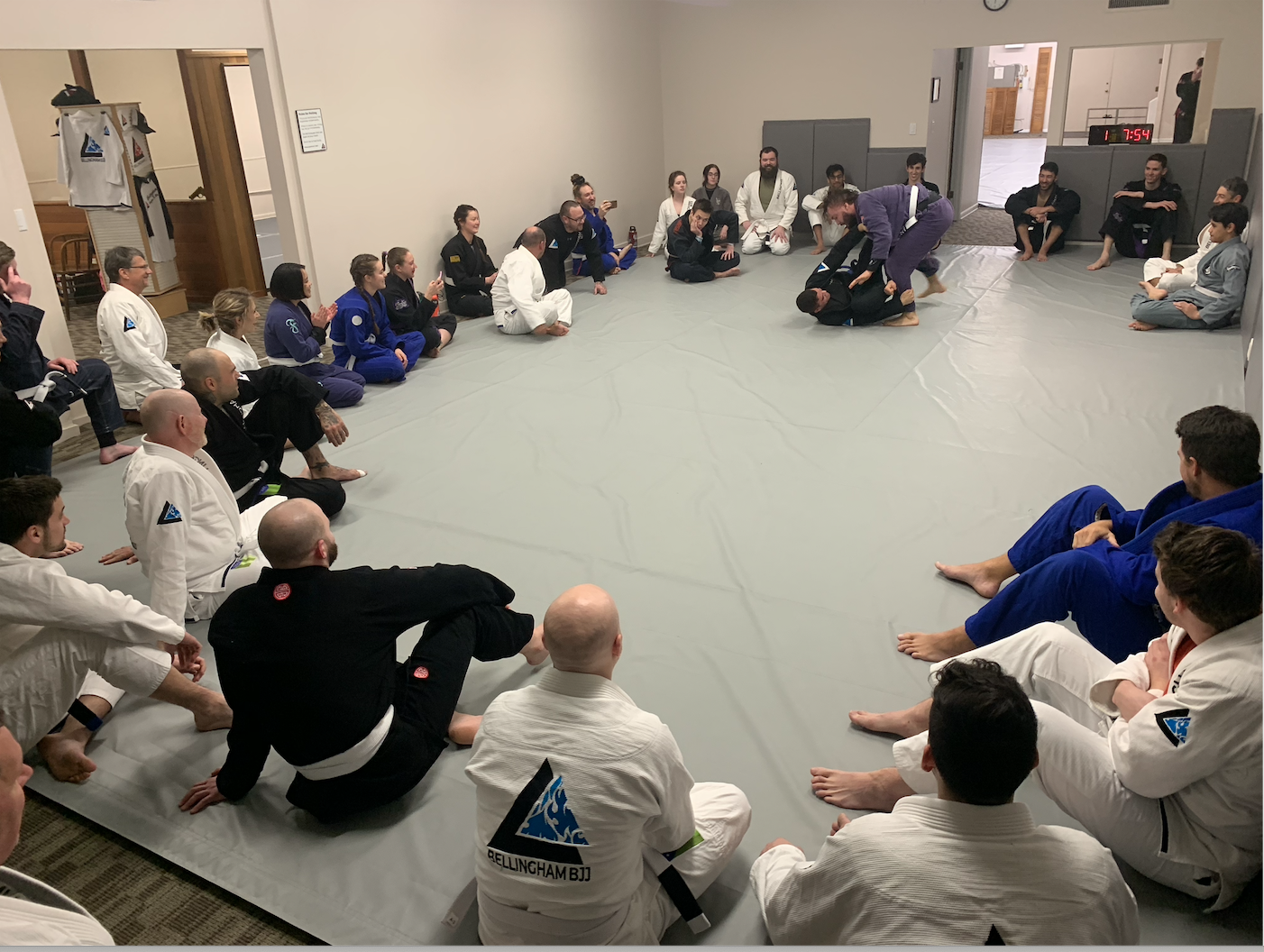One of toughest things to do — in life or in jiujitsu — is to fail properly.
But wait! I hear you say: If we’re failing, aren’t we, by definition, doing it wrong? Not at all: Failure is a part of everything, and the way we react to failure determines everything.
Jiujitsu is powerful because it is utterly unforgiving of the little myths our minds tend to create. During my first ever jiujitsu sparring session, I assumed my high school wrestling background would make me relatively safe from non-wrestlers’ takedowns. A few years later, I assumed I was safe from a no-arm triangle … until I grappled with a guy at Unity who specializes in it.
This is the power of jiujitsu: the power to make us confront reality. If we view it in this light, failure is a gift. Failure shows us the holes we need to patch, the territory we have to explore, the way forward that we haven’t taken yet. If you’re never failing, you’re probably not challenging yourself, which is no way to live your life.

We all have our little myths challenged sometimes. Think you can’t get smashed by that new guy who wrestled in college? You might have to think again once you grapple. Do you consider yourself a no-gi specialist and think that you’ll be able to heel hook the person who mostly trains in the gi? Maybe … but maybe not. Think you’re safe from a choke if your partner only has one arm around your neck? Someone that knows how to do it will test your theory. Once the results are in, we have the choice about whether to accept the results or be in denial about them.
Failure isn’t an end-state. Failure is a tool. Like any instrument, it can be used correctly or incorrectly. A handheld circular saw is an amazing tool, but if you use it to cut pizza, your lunch date might go badly.
So how do we fail correctly? Here are five tactics to use when trying to improve and 10 things you definitely should not do in response to failure.
FIVE THINGS TO DO IN ORDER TO FAIL CORRECTLY
Stay positive. Failure isn’t the end: One thing Dave Porter (correctly) says is that black belts have failed more times than white belts have ever tried. Don’t get down on yourself. To paraphrase Samuel Beckett, fail better next time.
Accurately analyze the reasons for failure. Was it a technical error? If so, you can take steps to improve the technique through drilling, specialized instruction, positional grappling, or some combination of errors. Was it a failure of preparation? If so, you’ll have ideas about how to prepare better next time.

Sometimes, one simple mistake is what caused the failure, and it’s an easy mistake to correct. This isn’t always true: Often, several issues worked together to undermine our performance. Prioritizing what needs fixing now and what else can work on later is a critical part of long-term growth.
Inextricably linked to this is …
Take responsibility. Worry about the things you can control. There will always be extraneous factors that affect performance — we can’t change the weather, or what’s going on with extended family, or whether you had to wait two hours for your division to go off. We can’t worry ourselves with these things. There are always these things. But there are also always things we can improve to make our performance stronger next time.
Use thoughtful self-criticism, and take the advice of qualified others. We can’t be fully objective about our own performance. Being more self-aware is a skill like any other, and must be cultivated. But it’s also important to have trusted people around you that will tell you the truth — not necessarily just the truths you like hearing.
Finally:
Don’t assume everything you did was incorrect. Losing of any sort sucks. We can be emotional in the moment, and even get down on ourselves. Keep things in perspective. Even if you didn’t get the result you wanted, you almost certainly did some things well. Don’t throw the baby out with the bathwater, and don’t let your progress get lost in a bad result.
I’m not just talking about competition here, of course. This advice applies to your jiujitsu journey generally — if you have a bad training session, for example, or keep trying to implement a new guard passing strategy and keep getting swept or submitted. Failure is a part of life, which means it’s a part of our training — and not just in a competitive context.
Whether you’re a competitor or not, those five suggestions above will serve you well. Now, let’s talk about the things you must not do. Because there are more ways to make errors than ways to succeed, this list is twice as long.
TEN THINGS NOT TO DO UNLESS YOU WANT FAILURE TO BECOME NORMAL
Expect to succeed without putting in the work. We focus on fundamentals, because fundamentals are the building blocks of everything else. We’re building — and we don’t want to build on sand. Fun YouTube tricks can look cool, and at white or blue belt, you might catch some people with a move they’ve never seen before. But that success is illusory over the long run. Expecting to succeed without constant learning, drilling, and sparring is expecting a house built on a beach to stay stable in a hurricane.
Make excuses. Excuses are poison to progress. They have you focus on the wrong aspects of an outcome — the ones that you can’t change. Plus, have you ever listened to someone make excuses and think “man, y’know, you have a point”?

Focus on the rewards, not the process. We’re the luckiest people in the world in that we get to do this thing we love. This is its own reward. You have to love the process or the end result will always be corrupted. Don’t focus on things like belts, stripes, or medals. If you trust the process and do the work, those things will come and you’ll have a great time along the way. Focusing on the images of success will delay your progress toward actual success. Show up. Go to class. It solve everything. Really!
Have a sense of entitlement. The mats don’t owe us anything. Our instructors owe us their best effort to help us improve, and nothing more. Once, a guy came into the academy who had trained elsewhere. We asked him how many stripes he had on his white belt. He said “well, I should have three,” and proceeded to talk about how his previous instructor had let him down in that regard. This is the opposite of how our thinking about progress should be.
Blame others. Everyone has choices to make. Our choices lead us to places. All we can do as human beings is put ourselves in the best positions we can to succeed. Blaming others — whether it’s a coach, a nutritionist, a friend, a family member, or whoever — robs us of ownership over our own choices. This is a great way to slow progress toward self-improvement.
Complain about referees. This could fall under the umbrella of blaming others, but I think it’s worth highlighting, especially for competitors. If you didn’t agree with the points the referee awarded, work harder to submit your opponent. If you lost by advantage, score points. If you lost by referee’s decision, you shouldn’t have put the referee in that position. I tell all of my friends training for competition to have this attitude: “You have to be so much better that fair doesn’t matter.” That’s what we’re working toward. This keeps us focused on our own progress.
Ignore difficult realities. Everyone has a part of them that wants to cling to the myths. When you’re under a larger, stronger opponent, there’s a part of you that wants to think it would be different if you were younger, or bigger, or whatever. When you lose under a particular ruleset, it’s tempting to say “yes, but under a different ruleset …” when the reality is that we all agree to compete under the same rules.
Feel like you have to be in charge. Some days, you’re just getting smashed by someone better than you. Those are great days! We’re fortunate to have a team of great training partners, and to have access to some of the best minds in the combat sports world.

Best believe I’m taking their classes, drilling the moves they teach, and viewing them as a resource. Be grateful to have great jiujitsu around you, even if — especially if — they roll you up. Sometimes people see others’ achievements as a threat, instead of a collaborative asset that helps achieve shared progress.
If you have to always be the smartest person in the room, you’ll be in a lot of unproductive rooms.
***
With all that said, what does failure — or for that matter, success — mean?
Only you can define your goals. Everything depends on criteria. To some, life isn’t complete without a tournament gold medal. To others, competition isn’t a priority, but health and wellness are of primary importance. Then there are folks to whom self defense training takes primacy. To many, each of these matter, with varying degrees of importance.
None of these people are wrong. Your goals are your goals, and you should view success and failure in that context. Everything that brings you closer to winning that gold, dropping that weight, or being ready to defend strikes is a win. Things that take you further away are losses. And no matter what your long-term aim is, the advice in this post applies.
The job of your jiujitsu instructor isn’t to tell you what your goals are. Their job is to help keep you on the path toward achieving those goals — today, tomorrow, 5 years from now, and however long you train. That vision animates everything we do here. So keep thinking about those goals, keep failing (but better each time!), and above all, keep training.


EXCELLENT read, Jeff!
Great thoughts about life lessons, on and off the mats. Thanks!
Great advice. Taken to heart, and will earnestly apply.
Thanks Jeff, powerful article. It is a good reminder for me to acknowledge the ego and stay humble. I try to remember to engage everyone as a ally and potential resource of knowledge.